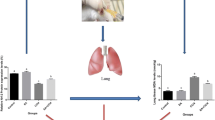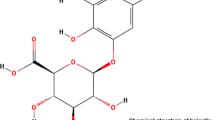Abstract
Bisphenol A (BPA) leads to ROS production that considered the core of different inflammatory and chronic obstructive pulmonary diseases. As a natural antioxidant, lycopene plays a significant role in the prevention of many chronic diseases. This study aimed to investigate the possible protective role of lycopene against BPA-induced lung alterations using morphometric, histological, immunohistochemical and biochemical methods. Forty rats aged 3 months were divided into four groups (n=10): control group, lycopene group comprising rats that received lycopene by gavage (10 mg/kg /day) for 30 days, BPA group comprising rats that received BPA by gavage (50 mg/kg/day) for 30 days and lycopene + BPA group. On the 30th day, blood and lung tissue samples were collected for biochemical, histological and immunohistochemical studies. Morphometrical and statistical analyses were performed. The BPA group revealed significantly elevated IL-1B, IL-6, MDA and NO, and it showed significantly reduced IL-10, SOD, CAT and GSH when compared to the control and lycopene + BPA groups. Upon histopathological and immunohistochemical examination, lycopene supplementation improved the BPA-induced alveolar collapse, lymphocytic infiltration, extravasated RBCs and fibrosis. The lycopene + BPA group showed significantly reduced mean percentage of 8-OHdG immunopositive and mean area percentages of Bax and caspase 3 immunopositive cells and significantly reduced mean area percentage of Bcl2 immunopositive cells as compared with the BPA group. Lycopene is a protective agent against BPA-induced lung injury because of its anti-apoptotic, anti-inflammatory and antioxidant effects, as confirmed by biochemical and histological studies.








Similar content being viewed by others
Data Availability
Not applicable.
References
Abdeen A, Ghonim A, El-Shawarby R, Abdel-Aleem N, El-Shewy E, Abdo M, Abdelhiee E (2017) Protective effect of cinnamon against cadmium-induced hepatorenal oxidative damage in rats. Int J Pharmacol Toxicol 5:17
Abdel-Daim MM, Abdeen A (2018) Protective effects of rosuvastatin and vitamin E against fipronil-mediated oxidative damage and apoptosis in rat liver and kidney. Food Chem Toxicol 114:69–77
Abdel-Daim MM, Eltaysh R, Hassan A, Mousa SA (2018) Lycopene attenuate tulathromycin and diclofenac sodium-induced cardiotoxicity in mice. Int J Mol Sci 19:1–15
Abedelhaffez AS, El-Aziz EAA, Aziz MAA, Ahmed AM (2017) Lung injury induced by bisphenol A: a food contaminant, is ameliorated by selenium supplementation. Pathophysiology. 24(2):81–89
Aboul Ezz HS, Khadrawy YA, Mourad IM (2015) The effect of bisphenol A on some oxidative stress parameters and acetylcholinesterase activity in the heart of male albino rats. Cytotechnology. 67(1):145–155
Aebi H (1984) Catalase in vitro. Methods Enzymol 105:121–126
Biswas SK, Rahman I (2009) Environmental toxicity, redox signaling and lung inflammation: the role of glutathione. Mol Asp Med 30(1-2):60–76
Brien EO, Dolinoy DC, Mancuso P (2014) Perinatal bisphenol A exposures increase production of pro-inflammatory mediators in bone marrow-derived mast cells of adult mice. J Immunotoxicol 11:205–212
Bruno KA, Mathews JE, Yang AL et al (2019) BPA alters estrogen receptor expression in the heart after viral infection activating cardiac mast cells and T cells leading to perimyocarditis and fibrosis. Front Endocrinol (Lausanne) 4:10–598
Buchwalow IB, Böcker W (2010) Working with Antibodies. In: Immunohistochemistry: basics and methods. Springer, Heidelberg, pp 31–39
Campos KKD, Araújo GR, Martins TL, Bandeira ACB, Costa GP, Talvani A, Garcia CCM, Oliveira LAM, Costa DC, Bezerra FS (2017) The antioxidant and anti-inflammatory properties of lycopene in mice lungs exposed to cigarette smoke. J Nutr Biochem 48:9–20
Cao Z, Wang P, Gao X, Shao B, Zhao S, Li Y (2019) Lycopene attenuates aluminum-induced hippocampal lesions by inhibiting oxidative stress-mediated inflammation and apoptosis in the rat. J Inorg Biochem 193:143–151
Choi YJ, Ha KH, Kim DJ (2017) Exposure to bisphenol A is directl associated with inflammation in healthy Korean adults. Environ Sci Pollut Res 24:284–290
El Morsy EM, Ahmed M (2020) Protective effects of lycopene on hippocampal neurotoxicity and memory impairment induced by bisphenol A in rats. Hum Exp Toxicol 39(8):1066–1078
Ellman M (1959) A spectrophotometric method for determination of reduced glutathione in tissues. Anal Biochem 74:214–226
El-Missiry MA, Othman AI, Al-Abdan MA, El-Sayed AA (2014) Melatonin ameliorates oxidative stress, modulates death receptor pathway proteins, and protects the rat cerebrum against bisphenol-A-induced apoptosis. J Neurol Sci 347(1-2):251–256
Fodor K, Tit DM, Pasca B et al (2018) Long-term resveratrol supplementation as a secondary prophylaxis for stroke. Oxidative Med Cell Longev 2018:4147320
Gassman NR (2017) Induction of oxidative stress by bisphenol A and its pleiotropic effects. Environ Mol Mutagen 58:60–71
Gowda BB, Yathish TR, Sankappa PS, Naik HK, Somayaji P, Anand D (2011) The response of oral submucous fibrosis to lycopene – a carotenoid antioxidant: a clinicopathological study. J Clin Diagn Res 5:882–886
Graziani NS, Carreras H, Wannaz E (2019) Atmospheric levels of BPA associated with particulate matter in an urban environment. Heliyon. 5(4):e01419
Gülçin İ (2012) Antioxidant activity of food constituents: an overview. Arch Toxicol 86(3):345–391
Hamed HS, Osman AGM (2017) Modulatory effect of lycopene against carbofuran toxicity in African catfish, Clarias gariepinus. Fish Physiol Biochem 43(6):1721–1731
Haq MEU, Akash MSH, Sabir S, Mahmood MH, Rehman K (2020) Human exposure to bisphenol A through dietary sources and development of diabetes mellitus: a cross-sectional study in Pakistani population. Environ Sci Pollut Res Int 27(21):26262–26275
He Q, Zhou W, Xiong C, Tan G, Chen M (2015) Lycopene attenuates inflammation and apoptosis in post-myocardial infarction remodeling by inhibiting the nuclear factor-κB signaling pathway. Mol Med Rep 11(1):374–378
Hortelano S, Genaro AM, Boscá L (1992) Phorbol esters induce nitric oxide synthase activity in rat hepatocytes. Antagonism with the induction elicited by lipopolysaccharide. J Biol Chem 267(35):24937–24940
Hu W, Wang H, Liu Z, Liu Y, Wang R, Luo X, Huang Y (2017) Neuroprotective effects of lycopene in spinal cord injury in rats via antioxidative and anti-apoptotic pathway. Neurosci Lett. 642:107–112
Huang FM, Chang YC, Lee SS, Ho YC, Yang ML, Lin HW, Kuan YH (2018) Bisphenol A exhibits cytotoxic or genotoxic potential via oxidative stress-associated mitochondrial apoptotic pathway in murine macrophages. Food Chem Toxicol 122:215–224
Jesuz VA, Elias Campos MB, Rosse de Souza V et al (2019) Lycopene and tomato sauce improve hepatic and cardiac cell biomarkers in rats. J Med Food 22(11):1175–1182
Jiang W, Guo MH, Hai X (2016) Hepatoprotective and antioxidant effects of lycopene on non-alcoholic fatty liver disease in rat. World J Gastroenterol 22(46):10180–10188
Jiang LN, Liu YB, Li BH (2018) Lycopene exerts anti-inflammatory effect to inhibit prostate cancer progression. Asian J Androl 21(1):80–85
Kasai H (1997) Analysis of a form of oxidative DNA damage, 8-hydroxy2 deoxyguanosine, as a marker of cellular oxidative stress during carcinogenesis. Mutat Res 387:147–163
Kensler TW, Wakabayashi N, Biswal S (2007) Cell survival responses to environmental stresses via the Keap1-Nrf2-ARE pathway. Annu Rev Pharmacol Toxicol 47:89–116
Kitade Y, Watanabe S, Masaki T, Nishioka M, Nishino H (2002) Inhibition of liver fibrosis in LEC rats by a carotenoid, lycopene, or a herbal medicine, Sho-saiko-to. Hepatol Res 22(3):196–205
Kobroob A, Peerapanyasut W, Chattipakorn N, Wongmekiat O (2018) Damaging effects of bisphenol A on the kidney and the protection by melatonin: emerging evidences from in vivo and in vitro studies. Oxidative Med Cell Longev 2018:3082438
Kong KW, Khoo HE, Prasad K, Ismail A, Tan CP, Rajab NF (2010) Revealing the power of the natural red pigment lycopene. Molecules 15(2):959–987
Korkmaz A, Ahbab MA, Kolankaya D, Barlas N (2010) Influence of vitamin C on bisphenol A, nonylphenol and octyl phenol induced oxidative damages in the liver of male rats. Food Chem Toxicol 48:2865–2871
Liu Y, Mei C, Liu H, Wang H, Zeng G, Lin J, Xu M (2014) Modulation of cytokine expression in human macrophages by endocrine-disrupting chemical bisphenol-A. Biochem Biophys Res Commun 451:592–598
Liu SH, Su CC, Lee KI, Chen YW (2016) Effects of bisphenol a metabolite 4-Methyl-2,4-bis(4-hydroxyphenyl)pent-1-ene on lung function and type 2 pulmonary alveolar epithelial cell growth. Sci Rep 16(6)39254
Lourenço SC, Moldão-Martins M, Alves VD (2019) Antioxidants of natural plant origins: from sources to food industry applications. Molecules 24(22):4132
Marklund SL (1985) Pyrogallol auto oxidation. In: Greenwald RA (ed) Handbook of methods for oxygen radical research. CRC Press, Boca Raton, pp 243–247
Martinez-Pinna J, Marroqui L, Hmadcha A, Lopez-Beas J, Soriano S, Villar-Pazos S, Alonso-Magdalena P, Dos Santos RS, Quesada I, Martin F, Soria B, Gustafsson JÅ, Nadal A (2019) Oestrogen receptor β mediates the actions of bisphenol-A on ion channel expression in mouse pancreatic beta cells. Diabetologia. 62(9):1667–1680
Matos HR, Marques SA, Gomes OF et al (2006) Lycopene and beta-carotene protect in vivo iron-induced oxidative stress damage in rat prostate. Braz J Med Biol Res 39(2):203–210
Mihara M, Uchiyama M (1978) Determination of malonaldehyde precursor in tissues by thiobarbituric acid test. Anal Biochem 86:271–278
Mohammed ET, Hashem KS, Ahmed AE, Aly MT, Aleya L, Abdel-Daim MM (2020) Ginger extract ameliorates bisphenol A (BPA)-induced disruption in thyroid hormones synthesis and metabolism: Involvement of Nrf-2/HO-1 pathway. Sci Total Environ 703:134664
Nakagawa Y, Tayama S (2000) Metabolism and cytotoxicity of bisphenol A and other bisphenols in isolated rat hepatocytes. Arch Toxicol 74:99–105
Palozza P, Parrone N, Catalano A, Simone R (2010) Tomato lycopene and inflammatory cascade: basic interactions and clinical implications. Curr Med Chem 235:1114–1125
Palozza P, Simone RE, Catalano A, Mele MC (2011) Tomato lycopene and lung cancer prevention: from experimental to human studies. Cancers. 3:2333–2357
Porrini M, Riso P (2000) Lymphocyte lycopene concentration and DNA protection from oxidative damage is increased in women after a short period of tomato consumption. J Nutr 130:189–192
Prasad AK, Mishra PC (2014) Modeling the mechanism of action of lycopene as a hydroxyl radical scavenger. J Mol Model 20(5):2233
Rencuzogullari N, Erdogan S (2007) Oral administration of lycopene reverses cadmium-suppressed body weight loss and lipid peroxidation in rats. Biol Trace Elem Res 118(2):175–183
Richeldi L, Collard HR, Jones MG (2017) Idiopathic pulmonary fibrosis. Lancet 389(10082):1941–1952
Savastano S, Tarantino G, D'Esposito V et al (2015) Bisphenol-A plasma levels are related to inflammatory markers, visceral obesity and insulin-resistance: a cross-sectional study on adult male population. J Transl Med 13:169
Savitskaya MA, Onishchenko GE (2015) Mechanisms of apoptosis. Biochemistry (Mosc) 80(11):1393–1405
Suvarna SK, Layton C, Bancroft JD (2013) Bancroft’s theory and practice of histological techniques, 7th edn. Churchill Livingstone, London
Tavakkoli A, Abnous K, Vahdati Hassani F, Hosseinzadeh H, Birner-Gruenberger R, Mehri S (2020) Alteration of protein profile in cerebral cortex of rats exposed to bisphenol a: a proteomics study. Neurotoxicology. 78:1–10
Tiwari D, Kamble J, Chilgunde S, Patil P, Maru G, Kawle D, Vanage G (2012) Clastogenic and mutagenic effects of bisphenol A: an endocrine disruptor. Mutat Res 743:83–90
Wang K, Zhao Z, Ji W (2019) Bisphenol A induces apoptosis, oxidative stress and inflammatory response in colon and liver of mice in a mitochondria-dependent manner. Biomed Pharmacother 117:109182
Xin F, Jiang L, Liu X, Geng C, Wang W, Zhong L, Chen M (2014) Bisphenol A induces oxidative stress-associated DNA damage in INS-1 cells. Mutat Res Genet Toxicol Environ Mutagen 769:29–33
Xu J, Huang G, Guo TL (2016) Developmental bisphenol A exposure modulates immune-related diseases. Toxics. 4(4):23
Funding
This work was supported by Taif University Researchers Supporting Project number (TURSP-2020/82)), Taif University, Saudi Arabia.
Author information
Authors and Affiliations
Contributions
N.M.F. prepared the idea and designed the study, analysed and performed the histological and morphometric examination of the lung; A.E. and A.F.G. analysed and performed the biochemical examination; N. M.F. and A.E. performed the experiment and prepared the manuscript draft. A.F.G and A.E. secured funding acquisition; N.M.F., A.E. and A.F.G reviewed and edited the manuscript. All the authors read and approved the final manuscript.
Corresponding author
Ethics declarations
Ethical approval and consent to participate
All procedures followed the guidelines of the Ethics Committee on the Use of Animals of theTaif University (approval no. 42-0053).
Consent for publication
Not applicable.
Conflict of interest
The authors declare no competing interests.
Additional information
Responsible editor: Mohamed M. Abdel-Daim
Publisher’s note
Springer Nature remains neutral with regard to jurisdictional claims in published maps and institutional affiliations.
Rights and permissions
About this article
Cite this article
Faheem, N.M., EL Askary, A. & Gharib, A.F. Lycopene attenuates bisphenol A–induced lung injury in adult albino rats: a histological and biochemical study. Environ Sci Pollut Res 28, 49139–49152 (2021). https://doi.org/10.1007/s11356-021-14140-w
Received:
Accepted:
Published:
Issue Date:
DOI: https://doi.org/10.1007/s11356-021-14140-w




